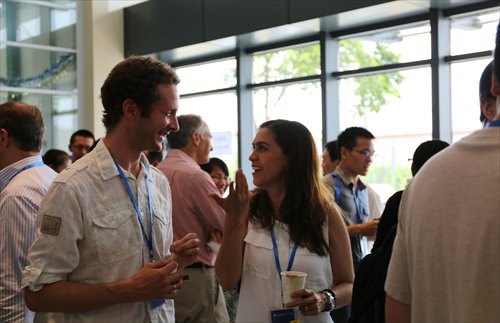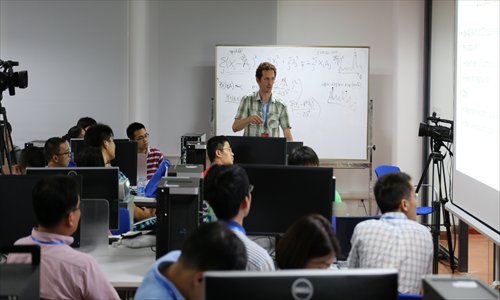HOME >> CHINA, METRO SHANGHAI
Scoping out Shanghai’s science scene
By Wang Zhefeng Source:Global Times Published: 2014-8-13 18:23:01
In the summer, when most schools and academic institutions are still on holiday, several splendid symposiums and summer schools have been taking place at universities and research institutes in Shanghai.
Among them, the 2014 Kuo Symposium on 3D Cryo Electron Microscopy Molecular Imaging and the K.H. Kuo Summer School of Electron Microscopy & Crystallography, which ran from July 26 to July 30 at the National Center for Protein Science Shanghai, was one of the top international events.
An Academician of the Chinese Academy of Sciences, Kuo was a pioneer physical metallurgist and crystallographer who also trained a generation of electron microscopists in China. Some of his former students are now well-established researchers in the field of structural biology and cryo electron microscopy. A symposium and summer school was established in 2008 to honor his achievements.
This year, more than 250 people attended the Kuo symposium. Among them were 30 prominent scholars from the US, the UK, Germany, the Netherlands and Japan, including two members of United States National Academy of Sciences and one member of Chinese Academy of Sciences who were invited to present their research works and hold training sessions for students and young scholars. More than 20 representatives from electron microscopy companies were also invited to exhibit their advanced technology.
Cheng Yifan is an associate professor at the University of California, San Francisco, and is an organizing committee co-chair of the symposium. He explained the progression of electron microscopy. "Microscopes are generally divided into light microscopes and electron microscopes. Normal people are more familiar with light microscopes, which are used even by middle school students. To further advance the resolution of microscopes in order to see things clearly, people invented the electron microscope in 1931 and kept improving it ever since," Cheng said.
"In 1970s and 1980s, European and American scientists developed cryo electron microscopy," Cheng said. "Chinese scientists imported the technology in 1990s. Concerning this technology, we have to freeze and maintain biological samples in liquid nitrogen temperature at -180 C so they maintain their original shapes. The resolution of single particle cryo electron microscopy, a major technique in this field, has now reached 0.3 to 0.4 nanometers, sufficient to resolve biological molecules at near atomic resolution."
Cheng said that at the National Center for Protein Science Shanghai, there is a Titan Krios 300KV cryo electron microscope, the most advanced in the world. He welcomes scientists from all over the world to do research with it.
Li Huilin (who is a former student of Kuo), Cong Yao and He Yongning are three other organizing committee co-chairs. The main purpose of the Kuo symposium is to advance the development of cryo electron microscopy and cultivate younger scientists, according to the three. All of the invited speakers are the best in the field. The goal is to put young students in close contact with the best scientists so they have an opportunity to learn about the most cutting-edge techniques and ideas in the field.
Lukas Bischoff is a German PhD student at Ludwig-Maximilians-Universität München, a university in Munich, Germany. He specially flew to Shanghai to attend the symposium. "I'd like to visit the world's top research center for protein science in Shanghai and have a good discussion with other international students and scholars," he said.
Bischoff enjoyed the entire seminar. "It had quite a good selection of speakers and topics. It let me understand the current state of the field of cryo electron microscopy and tomography," he said.
Yukihiko Sugita is a Japanese post doctorate scholar at the Okinawa Institute of Science and Technology Graduate University. Along with learning about the history, modern trends and future prospects of structural biology concerning electron microscopy, he also got some tips for operating an electron microscope that he could not learn from textbooks. "I had discussions with some great senior scientists on single particle analysis and tomography and learned about their career progression, which inspired me," Sugita said.
Sun Ying just graduated from the Mechanobiology Institute of National University of Singapore this year. Sun found the symposium was quite fruitful to her work. "I have been working on cellular tomography to understand the cellular structure in cells. There are lots of structures that are visible but we don't know what they are, because we don't have marker for cryo sample. It is a long-standing problem for biologists," Sun said. "During this symposium, I was excited to learn that many research labs and companies work together to correlate fluorescent microscopy with electron microscopy. In this way, we can see the possibility to discover and investigate more cellular architectures and processes in the future."



Among them, the 2014 Kuo Symposium on 3D Cryo Electron Microscopy Molecular Imaging and the K.H. Kuo Summer School of Electron Microscopy & Crystallography, which ran from July 26 to July 30 at the National Center for Protein Science Shanghai, was one of the top international events.
An Academician of the Chinese Academy of Sciences, Kuo was a pioneer physical metallurgist and crystallographer who also trained a generation of electron microscopists in China. Some of his former students are now well-established researchers in the field of structural biology and cryo electron microscopy. A symposium and summer school was established in 2008 to honor his achievements.
This year, more than 250 people attended the Kuo symposium. Among them were 30 prominent scholars from the US, the UK, Germany, the Netherlands and Japan, including two members of United States National Academy of Sciences and one member of Chinese Academy of Sciences who were invited to present their research works and hold training sessions for students and young scholars. More than 20 representatives from electron microscopy companies were also invited to exhibit their advanced technology.
Cheng Yifan is an associate professor at the University of California, San Francisco, and is an organizing committee co-chair of the symposium. He explained the progression of electron microscopy. "Microscopes are generally divided into light microscopes and electron microscopes. Normal people are more familiar with light microscopes, which are used even by middle school students. To further advance the resolution of microscopes in order to see things clearly, people invented the electron microscope in 1931 and kept improving it ever since," Cheng said.
"In 1970s and 1980s, European and American scientists developed cryo electron microscopy," Cheng said. "Chinese scientists imported the technology in 1990s. Concerning this technology, we have to freeze and maintain biological samples in liquid nitrogen temperature at -180 C so they maintain their original shapes. The resolution of single particle cryo electron microscopy, a major technique in this field, has now reached 0.3 to 0.4 nanometers, sufficient to resolve biological molecules at near atomic resolution."
Cheng said that at the National Center for Protein Science Shanghai, there is a Titan Krios 300KV cryo electron microscope, the most advanced in the world. He welcomes scientists from all over the world to do research with it.
Li Huilin (who is a former student of Kuo), Cong Yao and He Yongning are three other organizing committee co-chairs. The main purpose of the Kuo symposium is to advance the development of cryo electron microscopy and cultivate younger scientists, according to the three. All of the invited speakers are the best in the field. The goal is to put young students in close contact with the best scientists so they have an opportunity to learn about the most cutting-edge techniques and ideas in the field.
Lukas Bischoff is a German PhD student at Ludwig-Maximilians-Universität München, a university in Munich, Germany. He specially flew to Shanghai to attend the symposium. "I'd like to visit the world's top research center for protein science in Shanghai and have a good discussion with other international students and scholars," he said.
Bischoff enjoyed the entire seminar. "It had quite a good selection of speakers and topics. It let me understand the current state of the field of cryo electron microscopy and tomography," he said.
Yukihiko Sugita is a Japanese post doctorate scholar at the Okinawa Institute of Science and Technology Graduate University. Along with learning about the history, modern trends and future prospects of structural biology concerning electron microscopy, he also got some tips for operating an electron microscope that he could not learn from textbooks. "I had discussions with some great senior scientists on single particle analysis and tomography and learned about their career progression, which inspired me," Sugita said.
Sun Ying just graduated from the Mechanobiology Institute of National University of Singapore this year. Sun found the symposium was quite fruitful to her work. "I have been working on cellular tomography to understand the cellular structure in cells. There are lots of structures that are visible but we don't know what they are, because we don't have marker for cryo sample. It is a long-standing problem for biologists," Sun said. "During this symposium, I was excited to learn that many research labs and companies work together to correlate fluorescent microscopy with electron microscopy. In this way, we can see the possibility to discover and investigate more cellular architectures and processes in the future."

Scholars from around the world share ideas at the 2014 Kuo Symposium on 3D Cryo Electron Microscopy Molecular Imaging.

Scholars tour a lab at the National Center for Protein Science Shanghai.

A speaker gives a talk at the Kuo Summer School of Electron Microscopy & Crystallography. Photos: Courtesy of the National Center for Protein Science Shanghai
Posted in: Society, Metro Shanghai